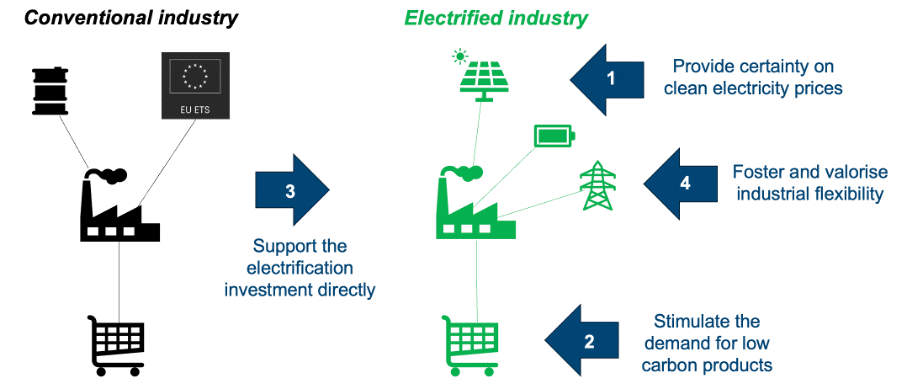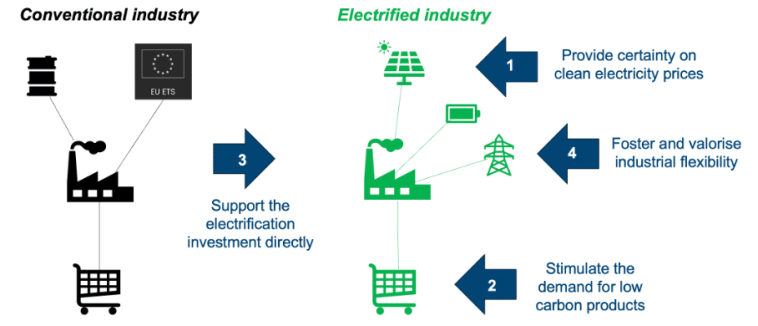
EU Climate Policy and Industry Support: A Balancing Act for 2040
The European Union is setting its sight on a bold climate target for 2040. In anticipation of a formal agreement at the upcoming summit, top EU leaders are discussing measures that could ease the transition for energy-intensive industries such as steel, automotive, and manufacturing. This opinion editorial takes a closer look at the proposed policy shifts, the tricky parts of funding low-carbon technologies, and the potential implications for industrial competitiveness in a changing global environment.
At the heart of these discussions is an effort to create an “enabling environment” designed to help businesses and citizens shoulder the costs related to the energy transition. With a focus on providing support to industries faced with tangled issues in shifting to low-carbon practices, the EU’s plan is expected to tackle some nerve-racking challenges while cementing its long-term climate commitment.
Policy Shifts and Financial Challenges in Decarbonization
EU leaders are walking a fine line as they work to define the 2040 emissions reduction target while ensuring that industrial enterprises remain competitive. The proposal, though not packed with new financial commitments like earmarked EU funding, leaves room for adjustments in mechanisms such as the carbon Boundary Adjustment Mechanism (CBAM).
Addressing Financing Concerns for Low-Carbon Transitions
One of the most intimidating parts of reaching a low-carbon economy is financing the transition. Several member states, including key players like France and Poland, have expressed concerns about how to cover the costs of implementing new technology. The proposed measures are designed to:
- Provide policy certainty for businesses
- Create predictable environments for technology investment
- Adjust tools like CBAM to support competitiveness
These steps are viewed as critical to fostering an industrial framework that can manage the twist and turns of achieving ambitious reduction goals without sabotaging global competitiveness.
How the European Commission’s Role is Evolving
The European Commission is tasked with crafting policies that ease the challenges faced by industries pursuing greener paths. Authorities are expected to design regulations that not only encourage environmental stewardship but also balance growth and competitiveness. In a nutshell, the Commission is being asked to:
- Develop flexible guidance on technology adoption
- Create supportive frameworks for energy-intensive sectors
- Coordinate funding mechanisms and incentives
This role is super important as it directly influences how state and private sectors invest in and adopt clean technologies – a process that can be both overwhelming and full of problems if not well managed.
Impacts on Energy-Intensive Industries
The industrial sectors most impacted by these ambitious climate targets include the steel, automotive, and chemical industries. These sectors have traditionally been the backbone of European manufacturing and exports. However, they now face a future where decarbonization could redefine operations and competitiveness.
Steel Industry: Managing the Transition Without Losing Competitiveness
Steel manufacturing is a perfect example of an industry in the crossroads, with a need to adapt its production processes to cleaner, more sustainable methods. The EU’s proposals indicate a commitment to ensuring that the steel sector can continue to thrive globally, even when confronted with the expensive journey towards low-carbon production.
| Aspect | Current Situation | Planned Measures |
|---|---|---|
| Carbon Costs | Increasing regulatory pressure and carbon pricing | Adjusted CBAM and financial support to cushion the price shock |
| Technology Transition | Heavy reliance on fossil fuels | Encouragement of fossil fuel-free steel production and new innovations |
| Global Competitiveness | Vulnerable to international trade pressures | Support measures to balance competitiveness with green transformation |
For many within the sector, the fine points of decarbonizing production without sacrificing profitability are indeed intimidating. The EU’s plan is to provide a structure that helps find your way through a maze of technological and financial obstacles.
Automotive Sector: Steering Through a Decarbonizing World
The automotive industry, traditionally reliant on internal combustion engine (ICE) vehicles, is at a pivotal moment. The discussions around 2040 have sparked debates that underscore both the promise of electric vehicles (EVs) and the challenges of phasing out ICE vehicles.
Key considerations in this sector include:
- Investment in EV technology and supporting infrastructure
- Regulatory adjustments to ease the transition for manufacturers
- Industry debates over the timeframe for phasing out traditional vehicles
Some countries are advocating for flexibility in terms of retiring ICE vehicles by 2035, while others push for stricter mandates. As the sector dig into these issues, manufacturers must manage the small distinctions between regulatory compliance and innovation-driven growth.
Industrial Manufacturing and the Broader Economic Impact
Changes in climate policy don’t only affect individual sectors—they have wide-reaching implications for the entire value chain and the economy overall. Energy-intensive industries are intricately linked to supply chains, labor markets, and global trade dynamics.
Supply Chain Adjustments and Global Trade
The multi-layered nature of today’s manufacturing supply chains means that any significant policy shift could send ripples through global commerce. For instance, if new tariffs or adjustments to CBAM are enacted, they may have the following effects:
- Shifting supplier relationships and sourcing strategies
- Encouraging the development of domestic industries to reduce import dependency
- Pressure on international partners to adapt similar environmental standards
Policymakers must take into account these hidden complexities, ensuring that while Europe paves the way for cleaner production, it does not inadvertently create bottlenecks in the supply chain or increase off-putting levels of trade tension.
The Multiplier Effect on Employment and Economic Growth
Industrial manufacturing is a major employer in several EU countries. Changes in this sector are destined to have a multiplier effect that touches on jobs, local economies, and even consumer confidence. Some of the critical impacts include:
- Demand for new technical skills as green technologies become mainstream
- Potential short-term job disruptions balanced by long-term sustainable employment in emerging sectors
- Economic growth spurred by innovation and an emphasis on environmental sustainability
However, the pathway is not without its twists and turns. Skill gaps, regional disparities, and the nerve-racking challenge of transitioning traditional roles to new, green functions all contribute to the tension. Policymakers and industry leaders must work closely to create reskilling programs and economic policies that smooth out these bumps.
Collaboration Between Government, Industry, and Stakeholders
One of the most stressed aspects in current debates is the importance of collaboration across various spheres of government, industry, and broader society. The success of the EU’s plan hinges on integrated efforts that bridge policy, funding, and innovation.
Public-Private Partnerships and Funding Initiatives
To manage the cost burdens of decarbonization, many suggest that public-private partnerships are essential. These collaborations can offer a multiplier of benefits, including:
- Access to state-backed funding sources that ease the transition for industries
- Sharing of technical know-how between private innovators and public research institutions
- Accelerating the pace at which low-carbon technologies are adopted on a large scale
Such partnerships are not only critical to financing new initiatives but also key to ensuring that diverse perspectives are taken into account. In this way, every actor from multinational corporations to local businesses has a role in shaping a future that is both sustainable and economically vibrant.
The Role of Political Will and Diplomatic Negotiations
The journey towards a 2040 climate target is riddled with political compromises and the slight differences that separate consensus from dissent. Member states are in prolonged discussions over how best to support industries while not undercutting diplomatic relations or the competitive edge of European businesses.
Some of the overhanging concerns include:
- How to equitably distribute the financial burdens of transitioning to low-carbon technologies
- Aligning national interests with the broader goals of the Union
- Handling negotiations around mechanisms like CBAM and other trade adjustments with finesse
This balance is tricky. However, the current momentum suggests that the EU is prepared to figure a path that, while full of problems and intimidating twists, aims to secure a cleaner, more competitive industrial future.
The Future of EU Climate and Industrial Policy
As the EU climate ministers plan to officially adopt the 2040 target ahead of COP30, the coming months will be critical. The policy landscape is set to undergo significant changes, with immediate impacts on funding routines, regulatory approaches, and international negotiations.
Technologically Neutral Approaches and Flexibility
A striking feature of the EU’s proposal is its commitment to a technologically neutral approach. This means that while the end goal remains fixed—reducing emissions by a set target—the methods by which industries achieve this transformation are left open.
For many stakeholders, this flexibility is a double-edged sword:
- It gives industries the freedom to adopt solutions that best match their unique needs.
- It reduces the pressure of a one-size-fits-all mandate that might not suit all sectors.
- It opens up room for innovation, allowing advancements in renewable energy, green steel, and even futuristic manufacturing techniques to flourish.
This flexibility is especially important as companies dig into the confusing bits and subtle differences between available clean technologies. By not prescribing a single path, the EU gives industries the super important ability to steer through the technological maze at their own pace.
Anticipating Global Competitiveness and Trade Dynamics
One aspect that cannot be ignored is the global context in which these changes take place. The EU is not working in isolation; rather, it is charting a course that will influence, and be influenced by, international trade dynamics and technological trends across the world.
Looking forward, several areas are set to be in the spotlight:
- How European manufacturers will maintain their edge in a global market rife with competition.
- The potential for export markets to influence domestic policies and vice versa.
- The possibility that international trade partners may look to Europe as a guidepost for future environmental policies.
These considerations underscore that while the EU’s climate policy is designed to be locally beneficial, its ripple effects could extend far beyond Europe’s borders. Global competitiveness, therefore, is both a driver for and a consequence of the evolving policy framework.
Sector-Specific Perspectives: Challenges and Opportunities
Looking at specific sectors reveals the full spectrum of challenges and opportunities. Each industry faces its own set of complicated pieces in the motion to become greener. Here we zoom in on two key sectors: manufacturing and transportation.
Manufacturing: Tackling the Tricky Parts of Technological Advances
Industrial manufacturing is one of the most pivotal areas that will feel the impact of the new climate targets. Manufacturers are working through several tricky parts as they adjust to new methods and technologies. Some of these challenges include:
- Integrating renewable energy sources into traditional production lines
- Updating equipment to be more energy efficient without disrupting existing processes
- Adapting to new regulatory requirements that affect product standards and export capabilities
These challenges, while off-putting at times, come with a myriad of opportunities. Manufacturers have the chance to:
- Modernize operations using state-of-the-art technology
- Create new job opportunities in advanced manufacturing and green tech sectors
- Benefit from government incentives that are designed to ease the transition and invest in training and development
The digital transformation of manufacturing, spurred by these environmental mandates, not only increases operational efficiency but also sets the stage for more resilient supply chains in a competitive global market.
Transportation: From Internal Combustion to Electric Mobility
The auto industry is a clear battleground where internal combustion engine vehicles are gradually giving way to cleaner, electric alternatives. This shift presents manufacturers with both overwhelming challenges and exciting breakthroughs.
In particular, the following issues are being hotly debated:
- Developing cost-effective, high-performance electric vehicles to meet consumer demand
- Building an extensive and reliable charging infrastructure that can support a growing fleet of EVs
- Creating strategies for managing the supply of critical components, such as batteries and electronic systems
Although these twists and turns may seem intimidating, the growth potential is significant. As manufacturers take a closer look at new technologies and explore innovative partnerships, the industry is poised for a wave of transformation that could redefine mobility for decades to come.
Policy Implementation and the Road Ahead
Implementing the 2040 climate target will require careful coordination between various government bodies, industry stakeholders, and international partners. The path forward involves sorting out many problematic elements and figuring a path through the transitions that lie ahead.
The Importance of Clear Guidelines and Transparent Processes
Clear, transparent guidelines are a must-have for businesses looking to invest in new technologies and processes. For many, the ambiguous bits of policy only add to the confusion and nerve-racking nature of large-scale transitions. To ease these concerns, policymakers aim to:
- Lay out clearly defined milestones and transitional benchmarks
- Engage in open dialogue with industry leaders to refine proposals before implementation
- Provide continuous updates on the progress of policy adjustments and technological breakthroughs
This process is similar to having a detailed roadmap, which not only reduces uncertainty but also provides industries with the small distinctions they need to adjust their strategies appropriately.
Stakeholder Engagement and Continuous Policy Adaptation
The EU’s policy framework must be flexible enough to evolve as new challenges and innovations emerge. This means that regular consultations with stakeholders will remain a key feature of the process. Some suggested approaches include:
- Regular public consultations and industry roundtables
- Feedback mechanisms that allow companies to report on the practical challenges they face
- Adaptive policy measures that can be fine-tuned as real-world impacts become apparent
This ongoing dialogue is super important to ensure that the policy remains responsive to the needs of all parties involved, and that companies can confidently take the wheel in steering through the changes.
Lessons from Past Transitions and Future Expectations
History shows that industrial transformations, while challenging, often create new opportunities for growth and innovation. The current transition to a low-carbon economy is no different. Many believe that with the right mix of supportive policies and robust public-private cooperation, the future of European industry is bright.
Learning from Previous Decade-long Transitions
Looking back at previous shifts—whether it was the digital revolution or earlier environmental regulations—reveals that the hidden complexities can be managed with clear strategies. Key lessons include:
- The need for early investment in technology and skills training
- Collaboration between industry, government, and research institutions
- Realistic timelines that allow for measured, gradual change
These lessons serve as a reminder that while the current path is filled with challenging bits and confusing pieces, the slow and steady approach can ensure long-term stability and competitiveness.
Setting Expectations for Economic Growth and Innovation
It is predicted that the push towards a low-carbon economy will bring with it a surge in innovation, new business models, and potentially, economic growth that outpaces current trends. Some of the expected benefits include:
- A boost in research and development for green technologies
- Creation of new markets and opportunities within the renewable energy sector
- Enhanced global competitiveness as European industries lead the way in sustainable practices
These opportunities do not come without their share of challenges. The road will be full of twisted and tangled issues, and each sector will have to dig into its own particular set of problems to chart a safe course forward. However, the overall sentiment remains optimistic if the EU’s measures are executed with commitment and transparency.
Conclusion: Charting a Sustainable Future Through Collaboration
The push towards a 2040 climate target is about more than environmental responsibility—it is a journey towards a more resilient, innovative, and competitive industrial base. While every sector from steel manufacturing to automotive and beyond faces overwhelming obstacles, decisive policy action and strong collaboration can help make the transition smooth and beneficial for everyone.
EU leaders are aware of the nerve-racking nature of a large-scale transformation. They have sought measures that not only provide technical and financial support but also create clarity on some of the most tangled issues that industries face today. With a strategically neutral approach to technology and an openness to adjust mechanisms like CBAM, the European policy framework is designed to be adaptive, supportive, and geared for long-term success.
The future will require public-private partnerships, transparent guidelines, and continuous dialogue to ensure that all stakeholders can get around the complicated pieces of decarbonization. As the EU gears up for the official adoption of the 2040 target ahead of COP30, it is clear that while the journey is fraught with twists, a collaborative approach can pave the way for a sustainable future that benefits industries, employees, and consumers alike.
Ultimately, the success of these measures will depend on the ability of both policy makers and industry leaders to work through the intricate layers of change. By getting into the subtle details of financing, regulatory adaptation, and technological innovation, the EU can create a model for a clean, competitive, and economically robust future that others around the world will undoubtedly follow.
In conclusion, the EU’s ambitious climate agenda is holding a mirror to the challenge of balancing environmental imperatives with industrial competitiveness. It is a bold experiment that, if managed well, may serve as an important blueprint for other global economies facing similar transitions. With the right mixture of commitment, collaboration, and clear policy direction, Europe is set to redefine what it means to thrive in a green economy, transforming nerve-racking challenges into opportunities for enduring growth and innovation.
Read more about this topic at
The Green Deal Industrial Plan – European Commission
The Next Chapter for US Green Industrial Strategy

